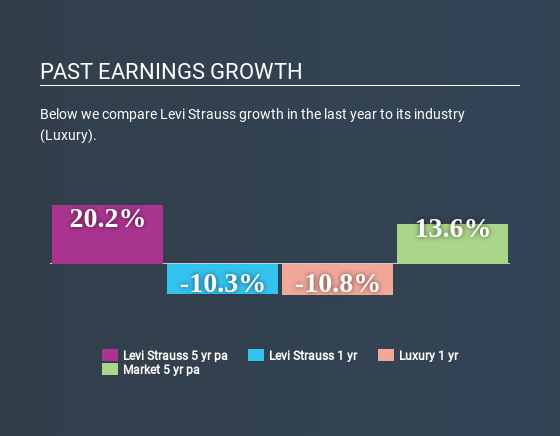Levi Strauss & Co.'s (NYSE:LEVI) Fundamentals Look Pretty Strong: Could The Market Be Wrong About The Stock?

Levi Strauss (NYSE:LEVI) has had a rough month with its share price down 14%. However, stock prices are usually driven by a company’s financial performance over the long term, which in this case looks quite promising. Specifically, we decided to study Levi Strauss' ROE in this article.
Return on equity or ROE is an important factor to be considered by a shareholder because it tells them how effectively their capital is being reinvested. In simpler terms, it measures the profitability of a company in relation to shareholder's equity.
See our latest analysis for Levi Strauss
How To Calculate Return On Equity?
ROE can be calculated by using the formula:
Return on Equity = Net Profit (from continuing operations) ÷ Shareholders' Equity
So, based on the above formula, the ROE for Levi Strauss is:
25% = US$401m ÷ US$1.6b (Based on the trailing twelve months to February 2020).
The 'return' is the profit over the last twelve months. One way to conceptualize this is that for each $1 of shareholders' capital it has, the company made $0.25 in profit.
What Has ROE Got To Do With Earnings Growth?
So far, we've learnt that ROE is a measure of a company's profitability. We now need to evaluate how much profit the company reinvests or "retains" for future growth which then gives us an idea about the growth potential of the company. Assuming all else is equal, companies that have both a higher return on equity and higher profit retention are usually the ones that have a higher growth rate when compared to companies that don't have the same features.
A Side By Side comparison of Levi Strauss' Earnings Growth And 25% ROE
Firstly, we acknowledge that Levi Strauss has a significantly high ROE. Secondly, even when compared to the industry average of 14% the company's ROE is quite impressive. As a result, Levi Strauss' exceptional 20% net income growth seen over the past five years, doesn't come as a surprise.
Next, on comparing with the industry net income growth, we found that Levi Strauss' growth is quite high when compared to the industry average growth of 2.5% in the same period, which is great to see.
Earnings growth is a huge factor in stock valuation. It’s important for an investor to know whether the market has priced in the company's expected earnings growth (or decline). Doing so will help them establish if the stock's future looks promising or ominous. If you're wondering about Levi Strauss''s valuation, check out this gauge of its price-to-earnings ratio, as compared to its industry.
Is Levi Strauss Making Efficient Use Of Its Profits?
The three-year median payout ratio for Levi Strauss is 29%, which is moderately low. The company is retaining the remaining 71%. So it seems that Levi Strauss is reinvesting efficiently in a way that it sees impressive growth in its earnings (discussed above) and pays a dividend that's well covered.
While Levi Strauss has been growing its earnings, it only recently started to pay dividends which likely means that the company decided to impress new and existing shareholders with a dividend. Upon studying the latest analysts' consensus data, we found that the company is expected to keep paying out approximately 31% of its profits over the next three years. As a result, Levi Strauss' ROE is not expected to change by much either, which we inferred from the analyst estimate of 25% for future ROE.
Conclusion
On the whole, we feel that Levi Strauss' performance has been quite good. Particularly, we like that the company is reinvesting heavily into its business, and at a high rate of return. Unsurprisingly, this has led to an impressive earnings growth. Having said that, looking at the current analyst estimates, we found that the company's earnings are expected to gain momentum. To know more about the latest analysts predictions for the company, check out this visualization of analyst forecasts for the company.
This article by Simply Wall St is general in nature. It does not constitute a recommendation to buy or sell any stock, and does not take account of your objectives, or your financial situation. We aim to bring you long-term focused analysis driven by fundamental data. Note that our analysis may not factor in the latest price-sensitive company announcements or qualitative material. Simply Wall St has no position in any stocks mentioned.
Have feedback on this article? Concerned about the content? Get in touch with us directly. Alternatively, email editorial-team@simplywallst.com.

 Yahoo Finance
Yahoo Finance 
